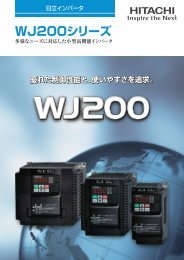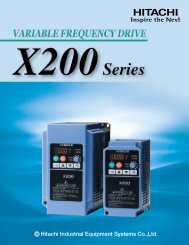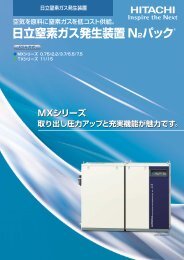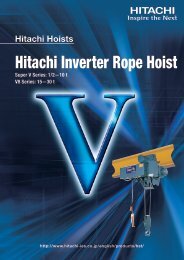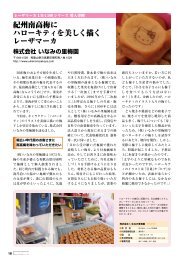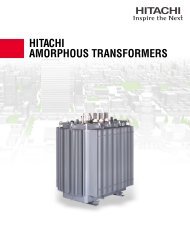Create successful ePaper yourself
Turn your PDF publications into a flip-book with our unique Google optimized e-Paper software.
[Installation location and operating environment]<br />
Avoid installation in areas of high temperature, excessive humidity, or where moisture can easily collect, as well as areas that are dusty, subject to corrosive<br />
gasses, mist of liquid for grinding, or salt. Install the inverter away from direct sunlight in a well-ventilated room that is free of vibration. The inverter can be<br />
operated in the ambient temperature range from -10 to 50˚C.(Carrier frequency and output current must be reduced in the range of 40 to 50˚C.)<br />
[Main power supply]<br />
Installation of an<br />
AC reactor on the<br />
input side<br />
In the following examples involving a general-purpose inverter, a large peak current flows on the main power supply side,<br />
and is able to destroy the converter module. Where such situations are foreseen or the connected equipment must be<br />
highly reliable, install an AC reactor between the power supply and the inverter. Also, where influence of indirect lightning<br />
strike is possible, install a lightning conductor.<br />
(A) The unbalance factor of the power supply is 3% or higher. (Note)<br />
(B) The power supply capacity is at least 10 times greater than the inverter capacity (the power supply capacity is 500<br />
kVA or more).<br />
(C) Abrupt power supply changes are expected.<br />
Examples:<br />
(1) Several inverters are interconnected with a short bus.<br />
(2) A thyristor converter and an inverter are interconnected with a short bus.<br />
(3) An installed phase advance capacitor opens and closes.<br />
In cases (A), (B) and (C), it is recommended to install an AC reactor on the main power supply side.<br />
Note: Example calculation with VRS = 205V, VST = 201V, VTR = 200V<br />
VRS : R-S line voltage, VST : S-T line voltage, VTR : T-R line voltage<br />
Using a private power<br />
generator<br />
Notes on Peripheral Equipment Selection<br />
Wiring connections<br />
Electromagnetic<br />
contactor<br />
Max. line voltage (min.) - Mean line voltage<br />
Unbalance factor of voltage = ---------------------------------------------------------------------------------------- X 100<br />
Mean line voltage<br />
VRS - (VRS + VST + VTR )/3 205 - 202<br />
= ----------------------------------------------- X 100 = ---------------------- X 100 = 1.5 (%)<br />
(VRS + VST + VTR )/3<br />
202<br />
An inverter run by a private power generator may overheat the generator or suffer from a deformed output voltage waveform<br />
of the generator. Generally, the generator capacity should be five times that of the inverter (kVA) in a PWM control system,<br />
or six times greater in a PAM control system.<br />
(1) Be sure to connect main power wires with R(L1), S(L2), and T(L3) terminals (input) and motor wires to U(T1), V(T2),<br />
and W(T3) terminals (output). (Incorrect connection will cause an immediate failure.)<br />
(2) Be sure to provide a grounding connection with the ground terminal ( ).<br />
When an electromagnetic contactor is installed between the inverter and the motor, do not perform on-off switching during<br />
running operation.<br />
Wiring<br />
between<br />
inverter and<br />
motor<br />
Thermal relay<br />
When used with standard applicable output motors (standard three-phase squirrel-cage four-pole motors), the <strong>SJ700</strong> and<br />
<strong>L700</strong> <strong>Series</strong> does not need a thermal relay for motor protection due to the internal electronic protective circuit. A thermal<br />
relay, however, should be used:<br />
during continuous running outside a range of 30 to 60 Hz.<br />
for motors exceeding the range of electronic thermal adjustment (rated current).<br />
when several motors are driven by the same inverter; install a thermal relay for each motor.<br />
The RC value of the thermal relay should be more than 1.1 times the rated current of the motor. Where the wiring length<br />
is 10 m or more, the thermal relay tends to turn off readily. In this case, provide an AC reactor on the output side or use a<br />
current sensor.<br />
Installing a circuit breaker<br />
Wiring distance<br />
Earth leakage relay<br />
Install a circuit breaker on the main power input side to protect inverter wiring and ensure personal safety. Choose an<br />
inverter-compatible circuit breaker. The conventional type may malfunction due to harmonics from the inverter. For more<br />
information, consult the circuit breaker manufacturer.<br />
The wiring distance between the inverter and the remote operator panel should be 20 meters or less.<br />
Shielded cable should be used on the wiring.<br />
Beware of voltage drops on main circuit wires. (A large voltage drop reduces torque.)<br />
If the earth leakage relay (or earth leakage breaker) is used, it should have a sensitivity level of 15 mA or more (per inverter).<br />
Phase advance capacitor<br />
High-frequency Noise and Leakage Current<br />
(1) High-frequency components are included in the input/output of the inverter main circuit, and they may cause interference in a transmitter, radio, or<br />
sensor if used near the inverter. The interference can be minimized by attaching noise filters (option) in the inverter circuitry.<br />
(2) The switching action of an inverter causes an increase in leakage current. Be sure to ground the inverter and the motor.<br />
Lifetime of Primary Parts<br />
Do not use a capacitor for power factor improvement between the inverter and the motor because the high-frequency<br />
components of the inverter output may overheat or damage the capacitor.<br />
Because a DC bus capacitor deteriorates as it undergoes internal chemical reaction, it should normally be replaced every 10 years. (10 years<br />
is not the guaranteed lifespan but rather, the expected design lifespan.) Be aware, however, that its life expectancy is considerably shorter<br />
when the inverter is subjected to such adverse factors as high temperatures or heavy loads exceeding the rated current of the inverter.<br />
JEMA standard is the 5 years at ambient temperature 40˚C used in 12 hours daily. (according to the " Instructions for Periodic Inspection of<br />
General-Purpose Inverter " (JEMA).)<br />
Also, such moving parts as a cooling fan should be replaced. Maintenance inspection and parts replacement must be performed by only<br />
specified trained personnel. Please plan to replace new INV depends on the load, ambient condition in advance.<br />
Precaution for Correct Usage<br />
Before use, be sure to read through the Instruction Manual to insure proper use of the inverter.<br />
Note that the inverter requires electrical wiring; a trained specialist should carry out the wiring.<br />
The inverter in this catalog is designed for general industrial applications. For special applications in fields such as aircraft, outer space, nuclear<br />
power, electrical power, transport vehicles, clinics, and underwater equipment, please consult with us in advance.<br />
For application in a facility where human life is involved or serious losses may occur, make sure to provide safety devices to avoid a serious accident.<br />
The inverter is intended for use with a three-phase AC motor. For use with a load other than this, please consult with us.<br />
Information in this brochure is subject to change without notice.<br />
Ambient temperature (˚C)<br />
50<br />
40<br />
30<br />
<strong>SJ700</strong><br />
2.5 5 10<br />
Capacitor lifetime (years)<br />
<strong>L700</strong><br />
30



